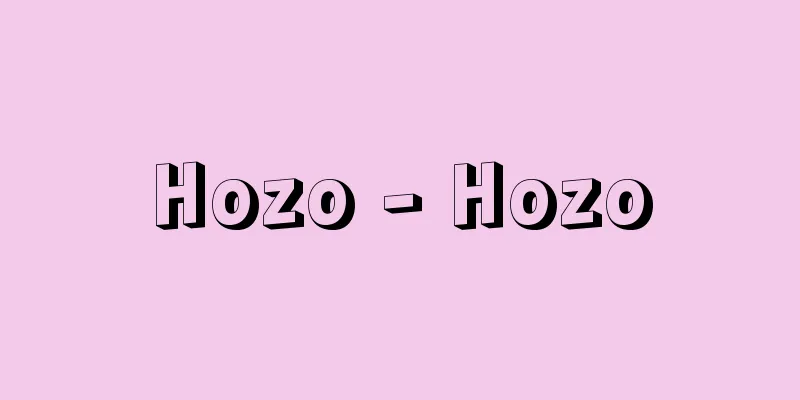Hozo - Hozo

|
A monk of the Huayan sect in the Tang dynasty in China. He is considered the third patriarch of the Huayan sect in China, having perfected Huayan doctrine. His secular surname was Kang. His ancestors served as the Prime Minister of Kangju (present-day Tashkent and Chimkent), but his grandfather naturalized him to China and lived in Chang'an. His father was called Hitsu, and served as a commander in the Left Guard. In 658 (the third year of the Xiankei era), when he was 16 years old, he is said to have burned one of his fingers in front of the Ashoka Stupa as a memorial. The following year, in 659, he entered Mount Taihaku in search of the teachings, but returned to Chang'an when his parents fell ill. He studied under Chigon (602-668) at the Unka Temple and listened to lectures on the Huayan Sutra for nine years. Two years after Zhiyan's death, in 670 (the first year of Xianheng), Empress Wu Zetian founded Taiyuan Temple to commemorate the soul of her biological mother, Lady Rongguo (579-670), and by imperial decree had Fatso shave his head and live there. Fatso was 28 years old at the time. After that, he lectured on the Avatamsaka Sutra more than 30 times and played an active role in the Buddhist world during the Wuzhou Dynasty. He assisted Jisha Nanda in translating the 80 volumes of the Avatamsaka Sutra, and was also involved in the translation of sutras by Jibakara (Nichizhao, 613-687), Daiun Hannya, Midasan, and Gijo. He also prayed for rain at Saimyō Temple and Daikonpuku Temple, and for snow at Goshin Temple, and is said to have had miraculous results. He passed away on November 14, the first year of the Senten era, at Daikonpukuji Temple in Saikyo. He was honored by the names of Master Kenju, Master Kosho, Priest Kozo, and Master Kegon. He wrote twenty volumes of the "Kegon Sutra Exploration Record," three volumes of the "Five Kegon Teachings" (also called the "Kegon Ichijo Doctrine Division Concise Chapter," "Kegon Sutra Division Notes," and "Ichijo Sutra Division Notes"); one volume of the "Moujin Gengenkan" (Contemplation of the Return to the Source of Delusion); one volume of the "Yushin Hokkaiki" (Record of the Wandering Mind's Realm); five volumes of the "Kegon Sutra Biography," and five volumes of the "Daijo Kishinron Giki" (Record of the Awakening of Faith in the Mahayana). He wrote many books, including five volumes of the "Commentary on the Bodhisattva Precepts of the Brahma Net Sutra," six volumes of the "Commentary on the Heart Sutra," and one volume of the "A Brief Commentary on the Heart Sutra." His disciples included Kokan, Buncho, Chiko, Shuichi, Eon (673?-743?), and Eei. [Rouen Ikeda April 18, 2017] "Study of the History of Chinese Huayan Thought" by Shigeo Kamata (1965, University of Tokyo Press)" ▽ "Buddhist Scriptures Lecture Series 28: The Five Huayan Teachings" by Shigeo Kamata (1979, Daizo Shuppan) [References] | | |Volume 1, compiled by Hozo, published in 1703 (Genroku 16), held at the National Diet Library "Exploring the Avatamsaka Sutra" Source: Shogakukan Encyclopedia Nipponica About Encyclopedia Nipponica Information | Legend |
|
中国、唐代の華厳(けごん)宗の僧。華厳教学の大成者で、中国華厳宗第三祖とされる。俗姓は康(こう)氏。先祖は代々康居(こうきょ)国(いまのタシケント、チムケントあたり)の丞相(じょうしょう)を務めたが、祖父の代に中国に帰化し、長安に住した。父の名は謐(ひつ)と称し、左衛中郎将であった。658年(顕慶3)16歳のとき阿育王舎利塔(あいくおうしゃりとう)前で一指を焼いて供養(くよう)したという。翌659年、法を求めて太白(たいはく)山に入ったが、親が病気になったので長安に帰った。雲華(うんげ)寺で智儼(ちごん)(602―668)に学び『華厳経』の講義を聞くこと9年に及んだ。智儼の入寂後2年、670年(咸亨1)に、則天武后は実母栄国夫人(579―670)の霊を供養するため太原寺(たいげんじ)を創建し、勅命を下して法蔵を落髪させこれに住せしめた。法蔵28歳のときのことである。以後『華厳経』を講ずること三十数回に及び、武周王朝期仏教界の第一人者として活躍した。実叉難陀(じっしゃなんだ)の『華厳経』80巻の訳出を助け、地婆訶羅(じばから)(日照。613―687)、提雲般若(だいうんはんにゃ)、弥陀山(みだせん)、義浄(ぎじょう)の訳経にも関係した。また、西明寺、大薦福寺で雨を祈り、悟真(ごしん)寺で雪を祈って、霊験があったという。先天(せんてん)元年11月14日、西京の大薦福寺で示寂。賢首(けんじゅ)大師、香象(こうしょう)大師、康蔵(こうぞう)法師、華厳和尚(おしょう)などと敬称される。『華厳経探玄記(たんげんき)』20巻、『華厳五教章(ごきょうしょう)』(『華厳一乗教義分斉章』『華厳教分記』『一乗教分記』とも)3巻、『妄尽還源観(もうじんげんげんかん)』1巻、『遊心法界記(ゆうしんほっかいき)』1巻、『華厳経伝記』5巻、『大乗起信論義記(だいじょうきしんろんぎき)』5巻、『梵網経菩薩戒本疏(ぼんもうきょうぼさつかいほんしょ)』6巻、『般若心経略疏(はんにゃしんぎょうりゃくしょ)』1巻など多数の著書があり、宏観(こうかん)、文超(ぶんちょう)、智光(ちこう)、宗一(しゅういち)、慧苑(えおん)(673?―743?)、慧英(ええい)らの弟子がいる。 [池田魯參 2017年4月18日] 『鎌田茂雄著『中国華厳思想史の研究』(1965・東京大学出版会)』▽『鎌田茂雄著『仏典講座28 華厳五教章』(1979・大蔵出版)』 [参照項目] | | | |巻1 法蔵撰 1703年(元禄16)刊国立国会図書館所蔵"> 『華厳経探玄記』 出典 小学館 日本大百科全書(ニッポニカ)日本大百科全書(ニッポニカ)について 情報 | 凡例 |
>>: Broadcasting - Broadcasting (English spelling)
Recommend
Colobus polykomos polykomos (English spelling) Colobuspolykomospolykomos
… [Kuroda Suehisa]. . . *Some of the terminology ...
Bergmann's rule
...This phenomenon is called Gloger's rule. S...
Coniferous - Coniferous
…The order Cordaites, Coniferales, and Taxales in...
Ring
〘Noun〙 ("Kin" is the Tang and Song pronu...
Kanzaki iris - Kanzaki iris
... I . fulva Ker-Gawl. (English name copper iris...
Wimbledon Tennis Tournament - Wimbledon Tennis Tournament
The world's oldest tennis tournament, first he...
Tan Xin Pei - Tan Xin Pei
1847‐1917 A late Qing Dynasty Peking Opera actor. ...
Sushi restaurant - Sushiya
[1] 〘 noun 〙 A shop that makes and sells sushi. Al...
Dumuzi (English spelling)
A Sumerian god, his name means "faithful son....
Gakashi paper
… Paper that has been made as is is called “raw p...
Simon, JA
…The Indian Courts Commission was established to ...
Ipheion uniflorum (Brodiaea uniflora); spring starflower
A perennial plant of the lily family, native to Ar...
The Chronicles of Sukekatsu
This is the diary of Hino Sukekatsu (1577-1639), a...
Bearing steel - Jikuukekou (English spelling) Bearing steel
Steel used for rolling bearings, containing about...
Church Music
In the narrow sense, it means music used in Chris...









